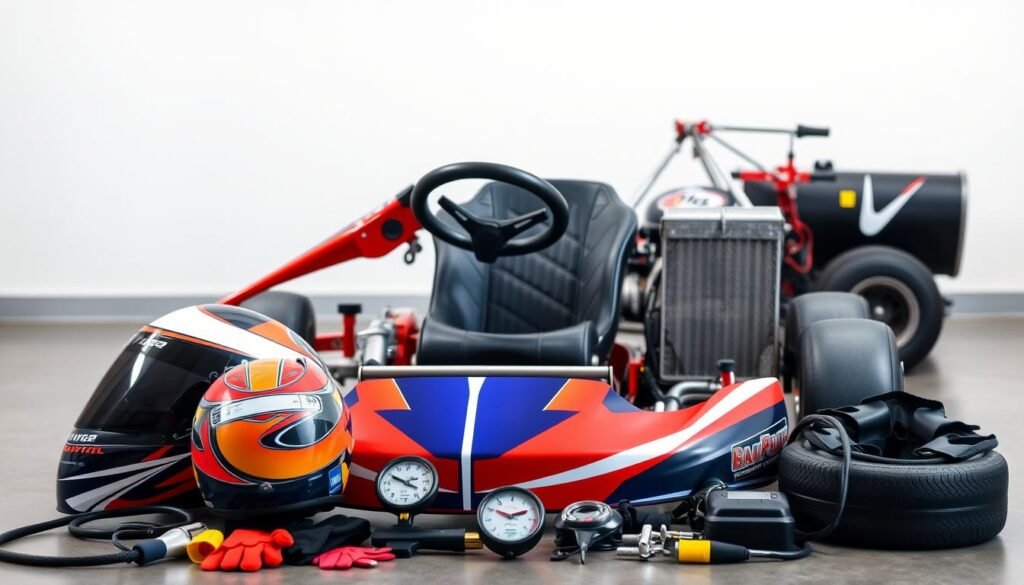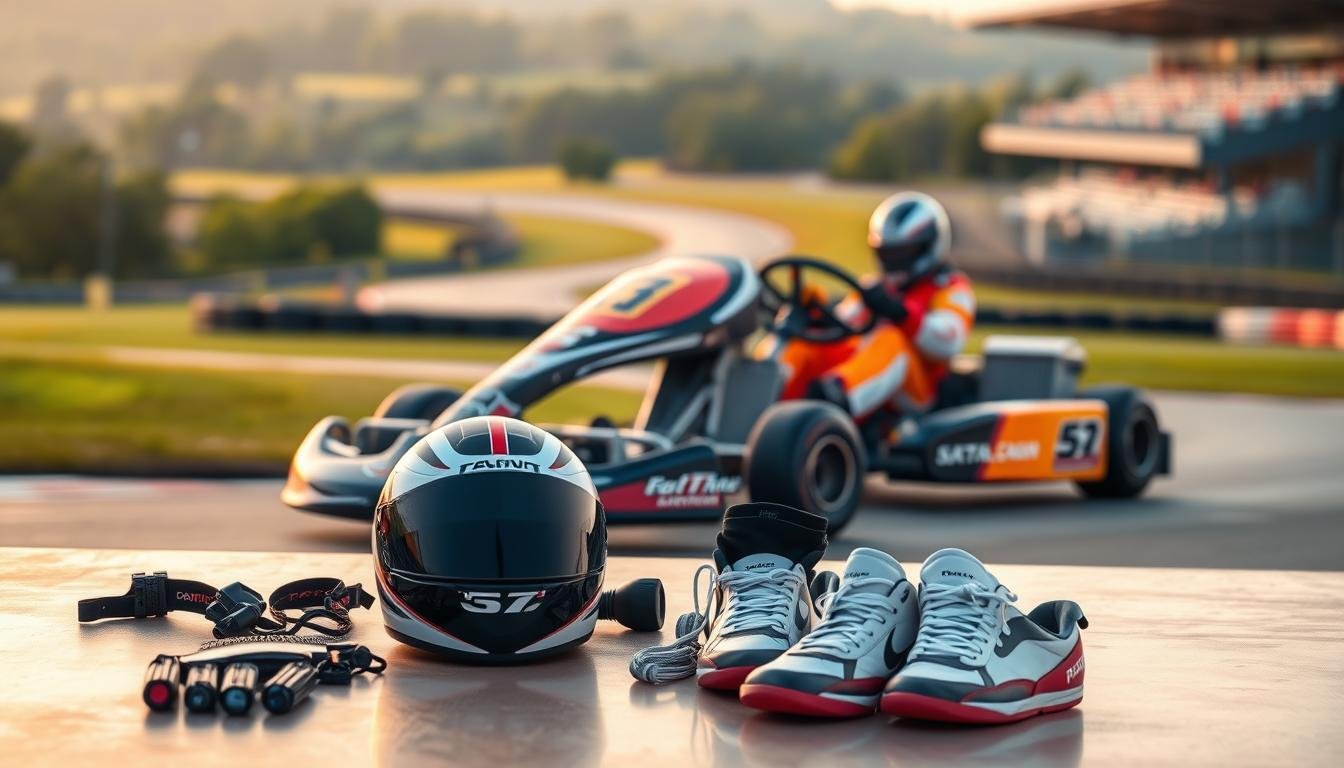Imagine launching a racing career where champions like Lewis Hamilton first gripped a steering wheel. Many Formula 1 legends began mastering vehicle control on compact tracks, proving karting’s role as the foundation of professional motorsport. This sport offers more than adrenaline—it’s a classroom for learning racecraft, vehicle dynamics, and strategic thinking.
Affordable entry costs make karting accessible to families and aspiring drivers. Unlike other forms of racing, expenses stay manageable while teaching critical skills like tire management and engine tuning. Drivers as young as seven can compete, with events welcoming participants well into their sixties. This inclusivity creates opportunities for multi-generational bonding on the track.
The skills gained here directly apply to higher-tier competitions. Racers develop reflexes, spatial awareness, and adaptability to changing track conditions. Professional teams often scout talent from karting circuits, recognizing its value in shaping disciplined, race-ready athletes. For those dreaming of a motorsport career, this is where the journey begins.
Key Takeaways
- Most Formula 1 champions began their careers in karting
- Affordable costs lower barriers to entry for new racers
- Teaches advanced skills like vehicle setup and race strategy
- Welcomes drivers aged 7 to 60+ for family-friendly competition
- Serves as a proven pathway to professional racing opportunities
Introduction to Karting and Motorsport
“If you think you’ve reached the limit in a kart, you’re only halfway there,” legendary driver Ayrton Senna once remarked about the sport’s demands. Professional kart racing operates through sanctioned events at dedicated facilities like Wisconsin’s Briggs & Stratton Motorplex, where organized competition runs from spring through fall. These venues feature technical tracks that challenge drivers’ precision while maintaining strict safety standards.
Unlike amusement park go-karts, purpose-built racing machines mirror Formula car engineering. Lightweight frames and high-performance engines require advanced driving techniques – skills that translate directly to stock cars and open-wheel series. Clubs like the Road America Karting Club demonstrate the sport’s structure, with 100+ members participating in weekly races governed by standardized rules.
Three elements define competitive karting:
- Professional-grade equipment meeting strict technical regulations
- Age-diverse events (junior to senior divisions)
- Real-time data analysis for performance optimization
Adult drivers often dominate podium positions, disproving the myth that karting serves only as a youth activity. The physical intensity rivals higher-tier motorsports – races demand sustained focus while managing lateral G-forces equivalent to production sports cars. This environment cultivates racecraft that professional teams actively seek in emerging talent.
Understanding the Basics of Kart Racing
In 1956, a California mechanic bolted a lawnmower engine to a simple frame, unknowingly creating motorsport’s most effective training tool. This raw design remains central to karting’s identity, offering unmatched responsiveness that sharpens core racing skills.
History and Evolution of Karting
What began as backyard tinkering evolved into a global phenomenon through standardized rules. The FIA recognized karting’s potential in 1962, establishing safety protocols and class structures still used today. Early races on parking lots transitioned to specialized circuits with banked turns and elevation changes.
Fundamental Driving Techniques
Mastering these vehicles requires precise inputs. Drivers lean their bodies to influence weight transfer, compensating for the lack of suspension. Smooth throttle control prevents wheel spin, while late braking maximizes speed through corners.
Three critical skills separate contenders:
- Reading track surfaces for optimal grip zones
- Maintaining momentum through complex chicanes
- Adjusting lines based on tire wear during long races
These techniques forge muscle memory that translates directly to Formula cars. Champions like Mario Andretti credit karting’s unforgiving nature for their ability to “feel” vehicle dynamics at elite levels.
Why Karting Is the Best Way to Start in Motorsport
Statistics show 89% of current Formula 1 drivers began competitive racing in karts before age 12. This proving ground demands mastery of car control and race strategy – skills that translate directly to professional circuits. Unlike motocross or junior car series, entry costs remain accessible, with full-season budgets often under $5,000.
- Practice tires cost 80% less than sports car equivalents
- Engine rebuilds average $300 vs. $3,000+ for motorcycles
- Track fees rarely exceed $50 per session
Simplified mechanics let newcomers focus on core techniques like weight transfer and apex targeting. Racers receive immediate feedback through lap timers and position changes – crucial for rapid improvement. Weekend events often feature multiple heats, compressing years of experience into months.
The sport’s intensity mirrors professional competition. Wheel-to-wheel battles teach spatial awareness and overtaking tactics from day one. Physical conditioning matches higher-tier series, with drivers burning 500+ calories per race while sustaining 2G cornering forces.
This environment forges complete athletes. Technical knowledge grows through hands-on setup adjustments, while racecraft sharpens through constant challenges. For those pursuing a career in motorsport, these fundamentals become the ultimate accelerator.
Essential Equipment and Setup for Kart Racing
Proper gear selection separates weekend hobbyists from serious competitors. New racers face two primary choices: factory-fresh packages ($2,000-$8,000) or pre-owned used karts ($1,500-$5,000). Seasoned drivers recommend starting with reliable second-hand models featuring straight frames and modern safety standards.

Choosing the Right Kart and Engine Options
Engine type dictates your racing experience. Two-stroke motors mix oil with fuel for explosive power, while four-cycle designs offer predictable torque and easier maintenance. Top chassis brands like Birel and Margay dominate competitive circuits, but local dealer support often determines long-term success.
Three factors guide smart purchases:
- Frame compatibility with regional race classes
- Availability of replacement parts
- Engine rebuild costs (average $300 vs. $1,200)
Budgeting for Parts, Tools, and Maintenance
A $500 starter toolkit covers essentials: tire pressure gauges, sprocket sets, and chassis alignment tools. Allocate 30% of your budget to safety gear – helmets and rib protectors can’t be compromised. Pro tip: Buy spare tires and seat brackets early – these wear items frequently cause mid-race exits.
Weekly maintenance preserves performance. Clean air filters prevent engine damage, while proper chain tension extends drivetrain life. Track-ready used karts often include upgraded components, letting beginners focus on driving rather than endless upgrades.
Getting Started: Budget Considerations and Beginner Tips
Smart budgeting separates spectators from competitors in entry-level motorsport. New racers get started with predictable expenses: $130 annual club fees and $30 nightly entry costs create accessible participation. First-year budgets typically range from $3,000-$6,000, covering essential gear and track time.
Prioritize safety equipment before performance upgrades. A Snell-certified helmet and rib protector form the foundation, averaging $300-$500. Season veterans recommend allocating 25% of your budget to spares – worn tires and engine parts demand frequent replacement.
Three cost-saving strategies prove valuable:
- Share trailer space with other racers to cut transportation fees
- Buy used practice tires ($50/set vs. $200 new)
- Learn basic maintenance to reduce mechanic bills
Storage solutions keep costs manageable. Most karts fit vertically in single-car garages, while compact trailers also need minimal parking space. Connect with local clubs to experience group discounts on bulk fuel purchases or track rentals.
Time investments matter as much as financial planning. Dedicate weekends to practice sessions while studying race footage between events. Seasoned competitors often mentor newcomers, accelerating skill development without costly trial-and-error learning.
The Role of Competition and Skill Development
At Michigan’s Jackson Speedway, novice drivers complete 50% more laps during practice days than competitive events—proof that repetition breeds racing excellence. Structured sessions let drivers refine techniques without championship pressure, building muscle memory through repeated cornering drills and speed management exercises.
Building Confidence Through Practice Sessions
Open Track Days offer 20 annual opportunities for skill-building. Each 15-minute session allows 30+ laps, giving drivers real-time feedback on line choices and braking points. This low-stakes environment helps newcomers master overtaking maneuvers before entering wheel-to-wheel battles.
Race series use smart progression systems to ease pressure. Beginners start at the field’s rear, focusing on clean laps rather than podium finishes. Drop days ensure missed events don’t penalize overall standings, encouraging risk-free experimentation.
Three elements accelerate growth:
- Immediate setup adjustments between sessions
- Gradual exposure to competition intensity
- Lap-time comparisons highlighting incremental gains
Physical endurance grows alongside mental resilience. Drivers learn to maintain focus through 2G cornering forces while processing split-second track changes. These skills form the bedrock for advanced motorsport disciplines, where milliseconds decide victories.
Overview of Kart Racing Classes and Formats
Modern karting circuits resemble chessboards with strategic divisions that match skill levels. Drivers compete in classes sorted by age and engine specifications, creating fair matchups across generations. From 5-year-olds in Kid Karts to seasoned 75-year-old competitors, the sport adapts to diverse ambitions.
Different Classes and Age Ranges
Youth divisions start with 20 mph Kid Karts for ages 5-8. Junior racers (9-15 years old) graduate to 50 mph machines, while Senior classes (16+) tackle advanced chassis setups. Masters categories welcome drivers over 35, proving speed isn’t bound by age.
Weight classifications balance competition. Light divisions suit 150 lb drivers; Heavy classes add ballast for 200+ lb participants. Weeknight series attract working adults with shorter 0.5-mile track events, while weekend warriors chase championships on full 0.8-mile circuits.
Comparing Two-Cycle and Four-Cycle Engines
Four-cycle engines dominate entry-level races with predictable power and lower maintenance. Two-cycle models deliver 30% more speed but require frequent rebuilds. The difference impacts budgets: $300 vs. $1,200 annual upkeep costs.
Shifter karts bridge the gap to pro racing with sequential gearboxes. These 80 mph machines demand expert control, while non-shifter classes focus on pure driving technique. Regional series often mix engine types to accommodate varied skill levels.
Safety, Maintenance, and Best Practices at the Track
Professional racers know victory depends equally on preparation and performance. Proper protocols protect drivers while extending equipment lifespan. A well-maintained machine paired with rigorous safety checks creates optimal conditions for success.
Pre-Race Preparation and Safety Gear
Begin each race day with a 15-point inspection. Check tire pressures, brake function, and fuel levels. Always wear a Snell SA2020-certified helmet – the gold standard for impact protection.
Essential gear includes flame-resistant suits and rib protectors. Gloves with reinforced palms improve grip during high-speed turns. Store equipment in climate-controlled spaces to prevent material degradation between events.
Post-Race Maintenance and Storage Tips
Clean karts immediately after leaving the track. Remove rubber buildup from chassis and inspect bearings for grit. Lubricate chains while warm for deeper penetration.
Store engines in dry environments with fuel lines drained. Use breathable covers to prevent moisture accumulation. Rotate tires weekly during off-seasons to maintain shape and elasticity.

Ramon Splinter is a passionate go-kart enthusiast and expert who shares valuable tips and insights on Zyorb, a blog dedicated to karting enthusiasts. With years of experience on the track, he specializes in helping beginners and seasoned drivers improve their skills, optimize their karts, and master racing strategies. His articles combine technical knowledge with practical advice, making go-karting more accessible and exciting for all.

